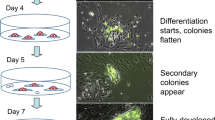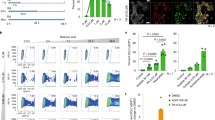Abstract
Pluripotent mouse embryonal carcinoma (mEC) and mouse embryonic stem (mES) cells differentiate into several cell lineages upon retinoic acid (RA) addition. Differentiation is facilitated, in part, by RA activation of nuclear RA receptors (RARs) that bind to DNA response elements located in the promoters of target genes. The purpose of the studies reported here was to immunolocalize RARα and RARγ protein in mEC and mES cells and in their RA-induced differentiated progeny. Fixed cells were reacted with three different RARα antibodies and one RARγ antibody. Pluripotent and differentiated mEC and mES cells showed positive nuclear immunoreactivity with all antibodies tested. Two RARα antibodies also showed positive reactivity in the cytoplasm. Surprisingly, our results revealed variability in immunofluorescence intensity and in RARα and RARγ distribution from one cell to the other, suggesting that RARα and RARγ protein levels were not synchronous throughout the cell population. The results indicate that RARα and RARγ are present in pluripotent and differentiating mEC and mES cells and suggest that the expression of these proteins is dynamic.






Similar content being viewed by others
References
Akmal KM, Dufour JM, Vo M, Higginson S, Kim KH (1998) Ligand-dependent regulation of retinoic acid receptor alpha in rat testis: in vivo response to depletion and repletion of vitamin A. Endocrinology 139:1239–1248
Asson-Batres MA, Smith WB (2006) Localization of retinaldehyde dehydrogenases and retinoid binding proteins to sustentacular cells, glia, Bowman's gland cells, and stroma: potential sites of retinoic acid synthesis in the postnatal rat olfactory organ. J Comp Neurol 496:149–171
Asson-Batres MA, Zeng MS, Savchenko V, Aderoju A, McKanna J (2003) Vitamin A deficiency leads to increased cell proliferation in olfactory epithelium of mature rats. J Neurobiol 54:539–554
Chen L, Khillan JS (2008) Promotion of feeder-independent self-renewal of embryonic stem cells by retinol (vitamin A). Stem Cells 26:1858–1864
Chiba H, Clifford J, Metzger D, Chambon P (1997) Distinct retinoid X receptor-retinoic acid receptor heterodimers are differentially involved in the control of expression of retinoid target genes in F9 embryonal carcinoma cells. Mol Cell Biol 17:3013–3020
Clagett-Dame M, DeLuca HF (2002) The role of vitamin A in mammalian reproduction and embryonic development. Annu Rev Nutr 22:347–381
Dey N, De PK, Wang M, Zhang H, Dobrota EA, Robertson KA, Durden DL (2007) CSK controls retinoic acid receptor (RAR) signaling: a RAR-c-SRC signaling axis is required for neuritogenic differentiation. Mol Cell Biol 27:4179–4197
Duong V, Rochette-Egly C (2010) The molecular physiology of nuclear retinoic acid receptors. From health to disease. Biochim Biophys Acta 1812:1023-1031
Gaub MP, Lutz Y, Ruberte E, Petkovich M, Brand N, Chambon P (1989) Antibodies specific to the retinoic acid human nuclear receptors alpha and beta. Proc Natl Acad Sci USA 86:3089–3093
Gaub MP, Rochette-Egly C, Lutz Y, Ali S, Matthes H, Scheuer I, Chambon P (1992) Immunodetection of multiple species of retinoic acid receptor alpha: evidence for phosphorylation. Exp Cell Res 201:335–346
Germain P, Chambon P, Eichele G, Evans RM, Lazar MA, Leid M, Lera AR de, Lotan R, Mangelsdorf DJ, Gronemeyer H (2006) International Union of Pharmacology. LX. Retinoic acid receptors. Pharmacol Rev 58:712–725
Gudas LJ, Wagner JA (2011) Retinoids regulate stem cell differentiation. J Cell Physiol 226:322–330
Han YH, Zhou H, Kim JH, Yan TD, Lee KH, Wu H, Lin F, Lu N, Liu J, Zeng JZ, Zhang XK (2009) A unique cytoplasmic localization of retinoic acid receptor-gamma and its regulations. J Biol Chem 284:18503–18514
Hou Z, Peng H, White DE, Negorev DG, Maul GG, Feng Y, Longmore GD, Waxman S, Zelent A, Rauscher FJ III (2010) LIM protein Ajuba functions as a nuclear receptor corepressor and negatively regulates retinoic acid signaling. Proc Natl Acad Sci USA 107:2938–2943
Lalevee S, Bour G, Quinternet M, Samarut E, Kessler P, Vitorino M, Bruck N, Delsuc MA, Vonesch JL, Kieffer B, Rochette-Egly C (2010) Vinexinss, an atypical "sensor" of retinoic acid receptor gamma signaling: union and sequestration, separation, and phosphorylation. FASEB J 24:4523–4534
Lane MA, Xu J, Wilen EW, Sylvester R, Derguini F, Gudas LJ (2008) LIF removal increases CRABPI and CRABPII transcripts in embryonic stem cells cultured in retinol or 4-oxoretinol. Mol Cell Endocrinol 280:63–74
Mark M, Ghyselinck NB, Chambon P (2009) Function of retinoic acid receptors during embryonic development. Nucl Recept Signal 7:e002
Masia S, Alvarez S, Lera AR de, Barettino D (2007) Rapid, nongenomic actions of retinoic acid on phosphatidylinositol-3-kinase signaling pathway mediated by the retinoic acid receptor. Mol Endocrinol 21:2391–2402
Mey J, Schrage K, Wessels I, Vollpracht-Crijns I (2007) Effects of inflammatory cytokines IL-1beta, IL-6, and TNFalpha on the intracellular localization of retinoid receptors in Schwann cells. Glia 55:152–164
Microscopy Society of America (2003) Resolution on the ethics of digital imaging. Microsc Today 16:61
Napoli JL (1999) Interactions of retinoid binding proteins and enzymes in retinoid metabolism. Biochim Biophys Acta 1440:139–162
Okada Y, Shimazaki T, Sobue G, Okano H (2004) Retinoic-acid-concentration-dependent acquisition of neural cell identity during in vitro differentiation of mouse embryonic stem cells. Dev Biol 275:124–142
Quadro L, Hamberger L, Colantuoni V, Gottesman ME, Blaner WS (2003) Understanding the physiological role of retinol-binding protein in vitamin A metabolism using transgenic and knockout mouse models. Mol Aspects Med 24:421–430
Rochette-Egly C, Germain P (2009) Dynamic and combinatorial control of gene expression by nuclear retinoic acid receptors (RARs). Nucl Recept Signal 7:e005
Rochette-Egly C, Lutz Y, Saunders M, Scheuer I, Gaub MP, Chambon P (1991) Retinoic acid receptor gamma: specific immunodetection and phosphorylation. J Cell Biol 115:535–545
Thurnham DI, Northrop-Clewes CA (1999) Optimal nutrition: vitamin A and the carotenoids. Proc Nutr Soc 58:449–457
Underwood BA, Arthur P (1996) The contribution of vitamin A to public health. FASEB J 10:1040–1048
Vernet N, Dennefeld C, Rochette-Egly C, Oulad-Abdelghani M, Chambon P, Ghyselinck NB, Mark M (2006) Retinoic acid metabolism and signaling pathways in the adult and developing mouse testis. Endocrinology 147:96–110
Wolbach SB, Howe PR (1925) Tissue changes following deprivation of fat-soluble A vitamin. J Exp Med 62:753–777
Zechel C (2005) Requirement of retinoic acid receptor isotypes alpha, beta, and gamma during the initial steps of neural differentiation of PCC7 cells. Mol Endocrinol 19:1629–1645
Zile MH (2001) Function of vitamin A in vertebrate embryonic development. J Nutr 131:705–708
Acknowledgments
We thank James Asfour for technical support.
Author information
Authors and Affiliations
Corresponding author
Additional information
Funding from grant NIH/NIGMS/MBRS/SCORE S06 GM 008092 to M.A.A.B. was used to support these studies.
Electronic supplementary material
Below is the link to the electronic supplementary material.
Fig. S1
Western blot reacted with antibodies directed against retinoic acid receptor γ 453 (RARγ 453) and D-glyceraldehyde-3-phosphate dehydrogenase (GAPDH). Nuclear (N) and cytosolic (C) extracts from P19 mEC (lanes 2, 3), BL6 mES (lanes 6, 7), and R1 mES (lanes 8, 9) cells were separated on the same gel and transferred to the same blot. The blot was probed with RARγ 453 and GAPDH antibodies. Molecular weights were determined from markers separated on the gel (lanes 1, 10) and transferred to the polyvinylidene difluoride membrane (lanes 4, 5 contained a sample not relevant to this study and were removed from the image). (JPEG 36 kb)
Rights and permissions
About this article
Cite this article
Buchanan, F.Q., Rochette-Egly, C. & Asson-Batres, M.A. Detection of variable levels of RARα and RARγ proteins in pluripotent and differentiating mouse embryonal carcinoma and mouse embryonic stem cells. Cell Tissue Res 346, 43–51 (2011). https://doi.org/10.1007/s00441-011-1247-x
Received:
Accepted:
Published:
Issue Date:
DOI: https://doi.org/10.1007/s00441-011-1247-x




